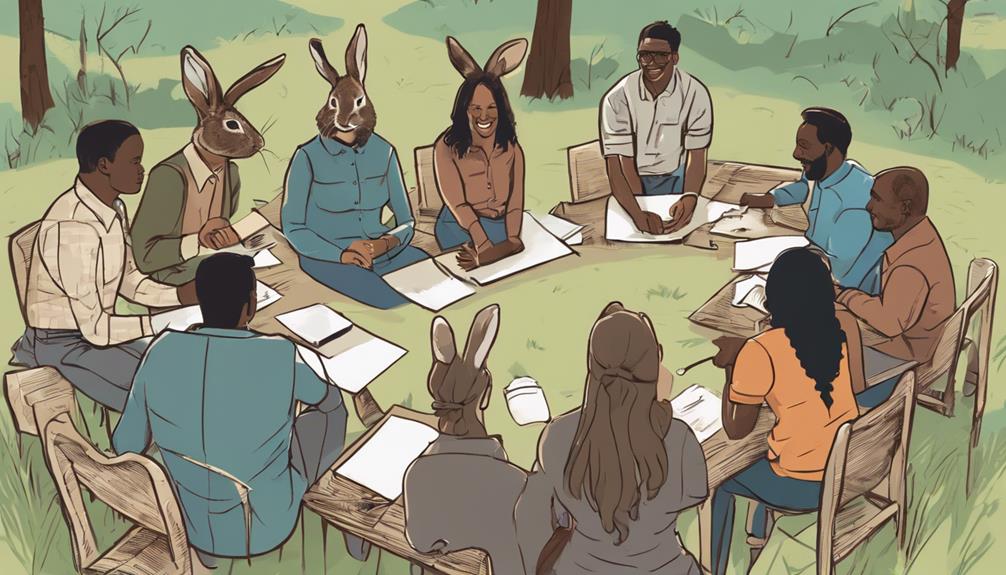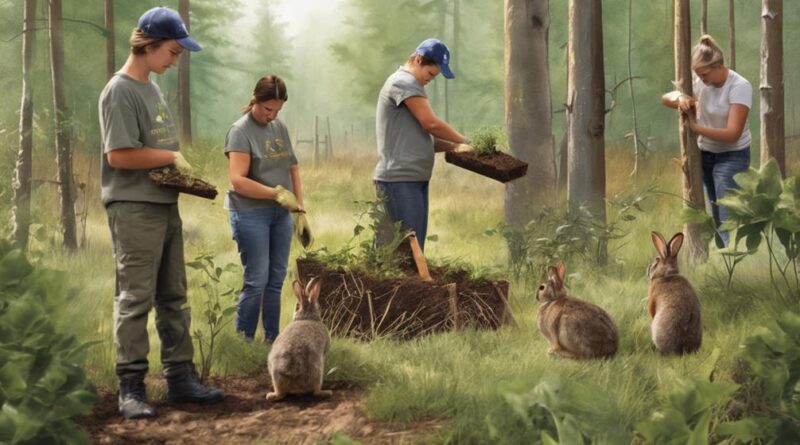7 Best Initiatives for Wild Rabbit Conservation
To preserve wild rabbits effectively, focus on habitat preservation, predator control, disease monitoring, community education, genetic diversity programs, habitat restoration projects, and advocacy efforts. Protect natural habitats, manage predators strategically, monitor diseases vigilantly, educate communities, maintain genetic diversity, restore habitats, and advocate for policies supporting conservation. By implementing a holistic approach that combines these initiatives, you can contribute significantly to the long-term well-being of wild rabbit populations. Further insights into these seven best initiatives await you.
Habitat Preservation
To ensure the long-term survival of wild rabbit populations, proactive measures must be taken to preserve and protect their natural habitats. Habitat preservation plays a crucial role in safeguarding the well-being of these creatures. One key aspect of habitat preservation for wild rabbits is the maintenance of suitable nesting sites. These sites are essential for the reproductive success and overall population growth of wild rabbits. By preserving areas with adequate vegetation cover and suitable soil conditions, you can ensure that wild rabbits have safe and secure locations to raise their young.
Moreover, the availability of diverse and abundant food sources is vital for the health and sustainability of wild rabbit populations. Wild rabbits are herbivores and rely on a variety of plants for their nutritional needs. By conserving natural habitats that offer a rich array of vegetation, you can help ensure that wild rabbits have access to the food sources necessary for their survival. This includes grasses, herbs, and shrubs that provide essential nutrients for wild rabbits to thrive.
Predator Control
Initiatives for wild rabbit conservation implement strategic predator control measures to mitigate threats to rabbit populations and enhance their survival prospects. Wildlife management programs often employ predator control as a crucial strategy to help maintain stable rabbit populations in their natural habitats. By managing predators effectively, conservationists aim to strike a balance that allows rabbits to thrive without causing harm to the overall ecosystem.
Population control is a key aspect of predator control in wild rabbit conservation efforts. Predators such as foxes, feral cats, and birds of prey can pose significant threats to rabbit populations if left unchecked. To address this, wildlife management teams may implement targeted predator removal programs in areas where rabbit populations are particularly vulnerable. These programs typically involve humane trapping and relocation methods to minimize harm to both predators and other wildlife species.
In addition to direct predator removal, conservationists also focus on habitat modifications to create safer environments for rabbits. This can include installing fencing to deter predators, creating predator-proof enclosures for vulnerable rabbit populations, and implementing vegetation management strategies to enhance cover and hiding spots for rabbits.
Disease Monitoring
In the realm of wild rabbit conservation, vigilance in disease monitoring plays a pivotal role in safeguarding rabbit populations from potential health threats. Preventative measures are crucial in managing diseases that can significantly impact wild rabbit populations. Through continuous research advancements, conservationists have been able to develop effective strategies for disease monitoring and control.
One key aspect of disease monitoring is the implementation of regular health checks on rabbit populations. By conducting thorough examinations and screenings, researchers can identify early signs of diseases and take necessary actions to prevent outbreaks. Additionally, collecting data on disease prevalence and transmission patterns enables conservationists to implement targeted interventions to mitigate risks.
Research advancements in the field of wild rabbit conservation have led to the development of innovative tools for disease monitoring. For instance, the use of advanced technologies such as remote sensing and genetic analysis has revolutionized the way diseases are detected and monitored in wild rabbit populations. These tools not only enhance the efficiency of disease surveillance efforts but also provide valuable insights into disease dynamics and transmission pathways.
Community Education
Community education plays a crucial role in raising awareness and fostering active participation in wild rabbit conservation efforts. Wildlife workshops are an effective way to engage the community by providing hands-on experience and knowledge about wild rabbits, their habitats, and the threats they face. These workshops can offer insights into conservation strategies and encourage people to take action in protecting these animals.
Community outreach programs are essential for spreading information about the importance of wild rabbit conservation. By organizing events, such as talks, field trips, and habitat restoration activities, communities can come together to learn, share ideas, and work towards a common goal of preserving wild rabbit populations.
School programs are instrumental in instilling a sense of environmental stewardship in the younger generation. By integrating wild rabbit conservation topics into the curriculum, students can learn about the significance of biodiversity and the impact of human activities on wildlife. Involving schools in conservation campaigns can also help raise awareness among families and the broader community.
Conservation campaigns play a vital role in mobilizing support and resources for wild rabbit conservation. By leveraging social media, organizing fundraising events, and partnering with local businesses, conservation organizations can amplify their message and engage a wider audience in conservation efforts. Through these initiatives, communities can make a tangible difference in protecting wild rabbits and their habitats.
Genetic Diversity Programs
To ensure the long-term viability of wild rabbit populations, implementing Genetic Diversity Programs is imperative for preserving the species' genetic health and resilience to environmental challenges. Breeding programs play a crucial role in maintaining genetic diversity within wild rabbit populations. By carefully selecting breeding pairs based on their genetic makeup, conservation efforts can help prevent inbreeding and maintain a healthy gene pool.
Conservation efforts focused on genetic diversity programs often involve partnerships between wildlife biologists, geneticists, and conservation organizations. These collaborations work to identify key genetic markers that indicate diversity levels within wild rabbit populations. Through this research-driven approach, conservationists can make informed decisions when selecting rabbits for breeding programs, ensuring the preservation of diverse genetic traits.
In addition to preventing inbreeding, genetic diversity programs also enhance the overall resilience of wild rabbit populations. A diverse gene pool provides rabbits with a better chance of adapting to environmental changes, such as disease outbreaks or habitat loss. By incorporating genetic diversity into conservation strategies, researchers can help wild rabbits thrive in dynamic ecosystems.
Habitat Restoration Projects
Implementing habitat restoration projects plays a crucial role in bolstering the ecological resilience of wild rabbit populations. By focusing on enhancing plant diversity and creating wildlife corridors, these projects provide essential resources and safe passage for wild rabbits to thrive.
Plant diversity within habitats is fundamental for wild rabbits as it offers a variety of food sources, shelter, and nesting sites. Habitat restoration projects often involve planting native vegetation that supports the nutritional needs of wild rabbits. By increasing plant diversity, these projects contribute to the overall health and sustainability of rabbit populations.
Moreover, the creation of wildlife corridors is another key aspect of habitat restoration projects. These corridors are essential pathways that connect fragmented habitats, allowing wild rabbits to move between different areas safely. By establishing wildlife corridors, habitat restoration projects help mitigate the negative impacts of habitat fragmentation, enabling wild rabbits to access new resources, seek mates, and expand their territories.
Advocacy and Policy Influence

Advocating for strategic policy changes is essential to safeguarding the habitats and populations of wild rabbits. Lobbying efforts play a crucial role in influencing decision-makers to implement policies that prioritize wildlife conservation. Through targeted advocacy, organizations and individuals can drive policy reform that protects the natural habitats crucial for wild rabbit survival.
One key aspect of advocacy for wild rabbit conservation is engaging in lobbying efforts to ensure that laws and regulations are favorable to rabbit populations. This involves actively reaching out to policymakers, presenting scientific evidence, and proposing specific legislative changes that benefit wild rabbits. By participating in the legislative process, advocates can shape policies that promote habitat preservation and sustainable land management practices.
Policy reform is another critical component of advocacy for wild rabbit conservation. This includes pushing for the enforcement of existing wildlife protection laws, as well as advocating for the development of new policies that address emerging threats to wild rabbit populations. By working to update and strengthen conservation laws, advocates can create a more robust legal framework for safeguarding wild rabbits and their habitats.
Frequently Asked Questions
How Can Individuals Volunteer for On-The-Ground Rabbit Conservation Efforts?
If you want to volunteer for on-the-ground rabbit conservation efforts, consider joining habitat restoration projects or community engagement activities.
Get involved in disease monitoring and participate in population surveys to help gather essential data.
Your dedication and support can make a significant impact on the conservation of wild rabbit populations.
Look for local organizations or wildlife agencies that are actively working on these initiatives and reach out to offer your assistance.
What Are the Impacts of Climate Change on Wild Rabbit Populations?
Climate change impacts wild rabbit populations significantly. Habitat loss due to changing temperatures and altered precipitation patterns affects breeding patterns, reducing reproductive success.
Additionally, rising temperatures can lead to disease outbreaks, posing a threat to rabbit populations. These factors combined can also impact genetic diversity within rabbit communities, making them more vulnerable to environmental stressors.
Understanding these impacts is crucial for effective conservation strategies to protect wild rabbit populations.
Are There Any Specific Initiatives for Protecting Rare Rabbit Species?
When looking at protecting rare rabbit species, specific breeding and reintroduction programs play a crucial role. These initiatives aim to increase the population of endangered rabbit species by carefully selecting breeding pairs and releasing them back into suitable habitats.
How Do Conservation Efforts Adapt to Urbanization Affecting Rabbit Habitats?
When facing urbanization challenges, conservation efforts must adapt to habitat fragmentation impacting rabbit populations.
By implementing wildlife corridors, green spaces, and urban planning that considers wildlife habitats, conservationists can help mitigate the negative effects of urban expansion on rabbit populations.
These initiatives promote connectivity between fragmented habitats, allowing rabbits to move safely through urban areas and maintain genetic diversity crucial for their long-term survival.
What Role Do Indigenous Communities Play in Wild Rabbit Conservation?
Indigenous communities play a crucial role in wild rabbit conservation through their traditional knowledge and community engagement. Their deep understanding of local habitats and ecosystems can inform conservation efforts, helping to protect the natural environment that wild rabbits depend on.
Conclusion
In conclusion, by implementing these 7 initiatives for wild rabbit conservation, we can make a significant impact on preserving these vulnerable species.
Through habitat preservation, predator control, disease monitoring, community education, genetic diversity programs, habitat restoration projects, and advocacy efforts, we can ensure the long-term survival of wild rabbits.
It's crucial that we continue to prioritize these efforts to protect these important members of our ecosystem for future generations to enjoy.
